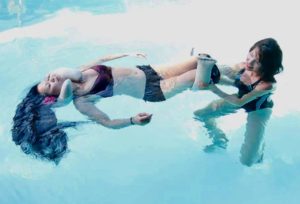The feeling of darkness; it can be serene with emptiness and freedom or become overwhelming with the abundance of thoughts that parade the brain. These experiences are unique to each individual. The goal each tries to seek while immersion into a floating bath is pure tranquility from a world of distractions and trauma. Trying to create the specific environment that enables the user to experience this type of serenity and benefit from the healing properties of the Watsu® (water shiatsu open air floating bath) is both the task of the patient and the administrator. The goal of providing this information is to help potential clients find the best suited form of treatment. The two types of floating baths examined here are the enclosing floating tank and an open air floating pool.
During the 1950’s neuropsychiatrists began experimenting with sensory deprivation tanks to study the activities human brain under isolated conditions. These are enclosed capsules just larger than the person fitting inside them. Filled with water raised to the temperature of the human skin 98.6 degrees fahrenheit is more relaxing and sedative than a bath at hotter or colder temperatures. The small, controlled environment allows scientists to study the patient through video monitors or a window. In a meditative state the patient’s brainwaves begin to change and plugs connected to key spots on the body and head can reveal these changes on graphs and an MRI machine. Some benefits have been seen through these experiments including a reduction in stress, especially for those suffering from extreme trauma such as PTSD. Other less medical accomplishments have included mental visualization for honing the body’s overall energy for physical accomplishments as in the case of runner Carl Lewis training for the 1988 Olympics.
In an open air floating pool like the ones at Aqua Car for Me located in the San Fernando Valley the practitioner immerses themselves in a larger room sized pool where they are not alone but accompanied with a guide to aid in stretching and comfort with a healing touch. As stretching is a main aspect of this technique, the larger sized bath allows for increased movement. The instructor is right next to the practitioner and with this new additions can be implemented such as the sound of soothing drums which aid in the meditation process, helping to achieve greater results.
While both the isolation tanks and the open air floating baths have shown similar results including lowered blood pressure, pain, muscle tension and a stress inducing hormone as well as enhancements in mood and overall health there have been far more reports of negative experiences from the isolation tanks. Describing feelings of being alone, claustrophobia, and the intimidation of the complete darkness the isolation tanks can be overwhelming for some. Open air baths eliminate these unpleasant aspects and can be considered a type of dance that in itself is a type of exercise along the lines of yoga.
If either practice is something you may be interested trying you will find locations the open air baths more inviting and usually cost effective. For a first time practitioner the isolation tanks may be a little too intense whereas the open air baths are established to create a much more inviting atmosphere and experience.

